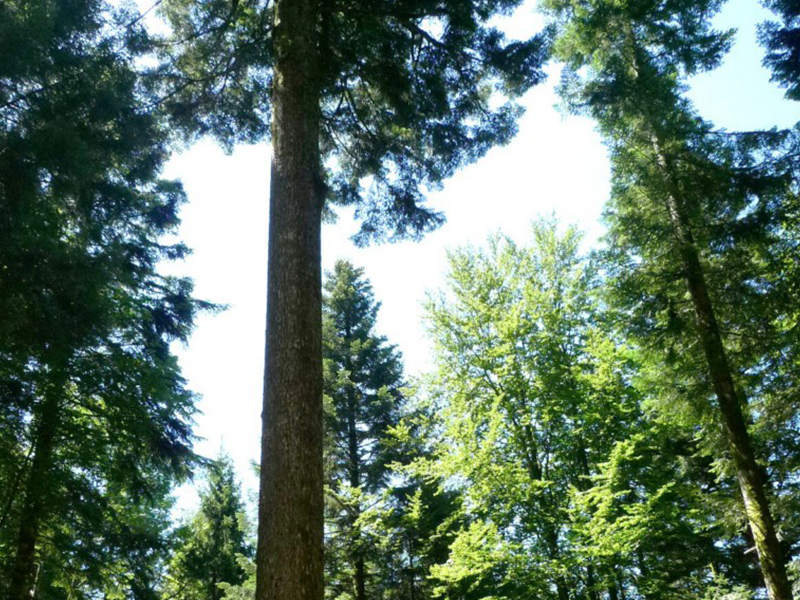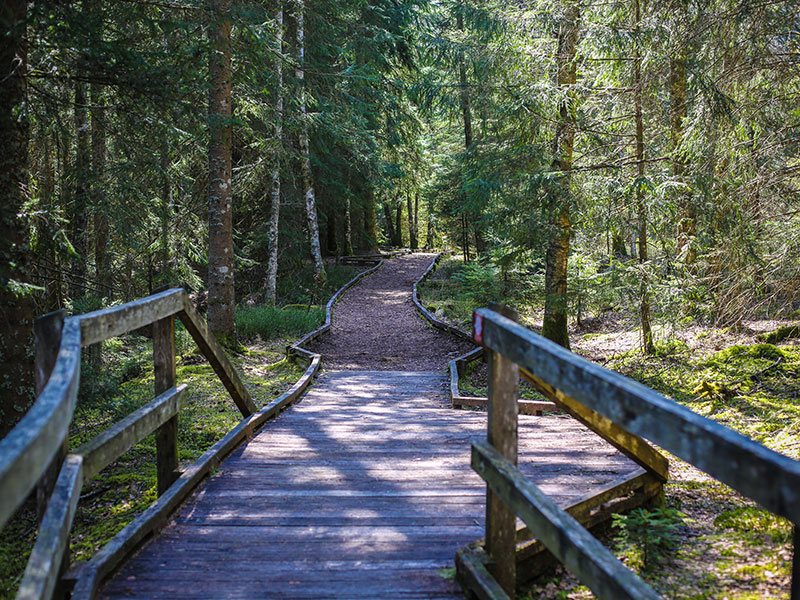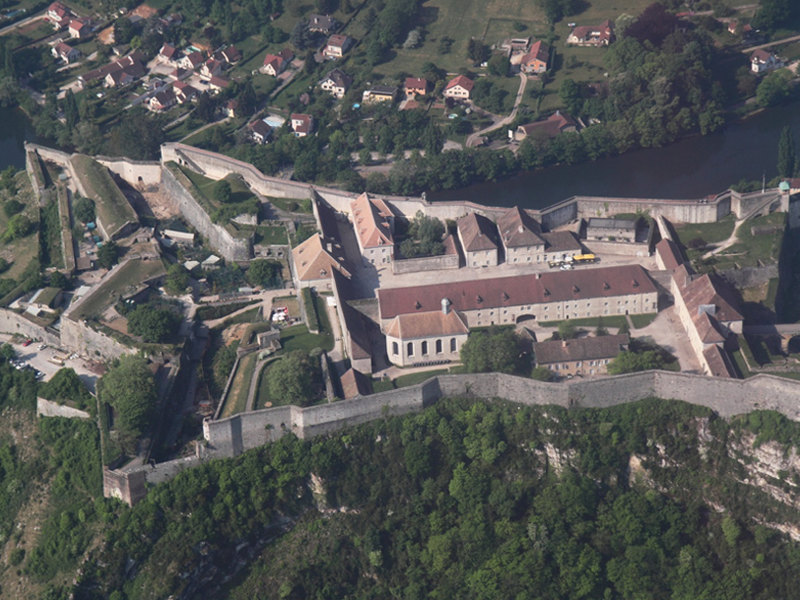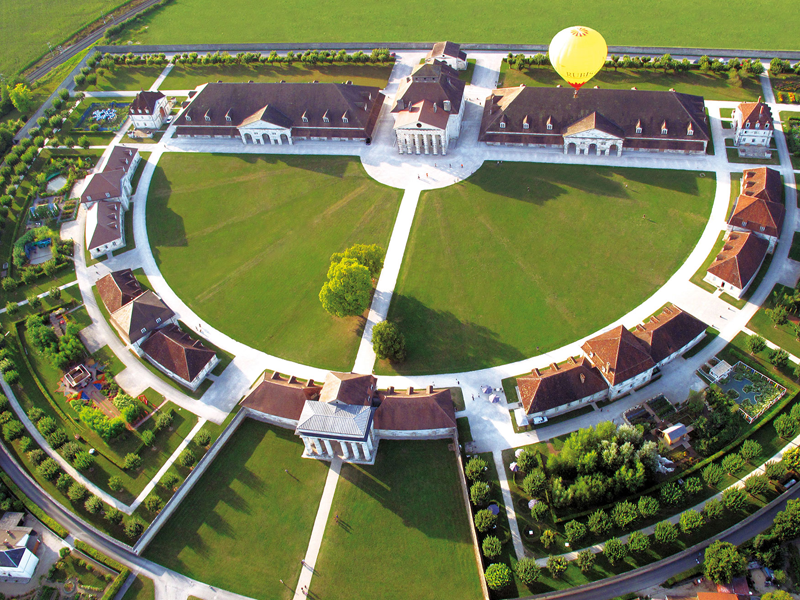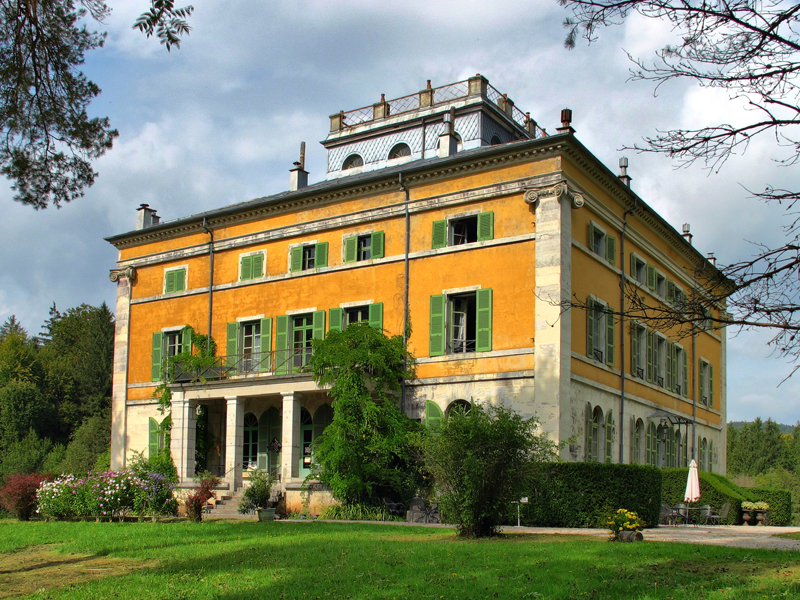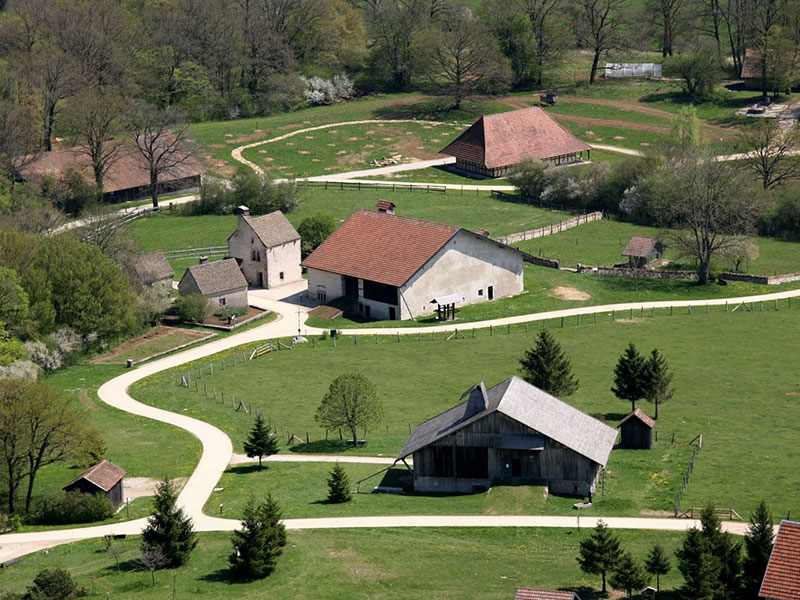Located in a beautiful 15th century manor house, renovated in 19th century in the Art Nouveau style, the Pontarlier Museum is well worth a visit for its high quality collections.
The area around the chateau de Joux includes many natural, historical, cultural and tourist sites that are well worth a visit when to come (or return) to Joux.
Exceptional sites
The Franche-Comté boasts a large number of remarkable tourist sites.
Within 50 km
Lakes and Mountains of the Haut Doubs
Saint Point lake, Malbuisson, for water sports, fishing and swimming.
The Mont D’or (highest summit of the Jura mountains at 1,463m), Métabief, Les Fourgs, for mountains, skiing, hiking trails, mountain bike trails, alpine pastures, a chance meeting with Capercaillie or a Lynx, breathtaking views of the Alps and Mont Blanc.The Doubs falls
The Doubs falls is a 27 metre high waterfall caused by a landslip 12,500 years ago, which caused a narrowing of the Doubs river, which runs its course along the Franco-Swiss border.
Ornans, the Gustave Courbet Museum, the source of the river Loue
“Petite Venise of the Comté”, land of Gustave Courbet, dont miss the Gustave Courbet Museum, the gorges and valleys of the Loue and Lison rivers, trout fishing, the farm at Flagey (12 km away) that belonged to Gustave Courbet’s parents and which hosts exhibitions.
The Gouffre de Poudrey (Etalans)
A cathedral 70 metre below ground, the Gouffre de Poudrey forms an oval gallery 130 metre long by 100 metres wide and the 4th largest underground room of this kind in France.
The Montbenoit Abbey
The Monbenoit Abbey is the only preserved medieval religious site of this size in the Doubs. It was probably founded in the 12thC by the Lords of Joux. The statue of Henry of Joux on horseback and the tomb of Berthe, Lady of Joux can both be found at the site.
The forest of Joux
One of the most impressive pine forests in the Jura, with some trees reaching heights of more than 50m – the equivalent of a 15 storey building! !
The peat bogs at Frasne eandt du Val de Drugeon
Their preserved fauna and flora make up a patchwork of habitats encompassing a wide range of wild flowers. These landscapes are reminiscent of the Far North of Europe.
Morteau, its famous sausage and its Clockmaking Museum
On the way to the Doubs falls, the town of Morteau is known in the food world for its smoked sausage. Its clockmaking museum tells the history of this industry in the Franche Compté since the 18thC. It houses an impressive collection of clocks, watches and very rare timepieces in a Renaissance manor house.
The Lison Spring and the Blade-making Museum
In Nans sous Sainte Anne, the Lison river starts as an impressive waterfall, rising out of large cave (which you can visit), its spring never dries up! The river then joins the Loue. The Blade-making Museum is set in a former factory and demonstrates the art of blade-making.
Nozeroy
A small medieval town, Nozeroy is home to a number of impressive monuments (including a collegiate church) food heritage in the form of butter, the source of the Ain river, the “assault on the ramparts” festival and the starting point of various hiking trails into the Joux forest.
Salins les Bains
The great saltworks at Salins-les-Bains was listed as a UNESCO world heritage site in 2009. The town has thermal waters with a higher level of salinity than the Dead Sea. impressive monuments, and high quality industrial and cultural heritage sites.
The Scey and Cleron chateaux
The chateau de Scey (a ruin) sits on a rocky buttress between the Loue valley and the Valbois ravine on the territory of Chassagne-Saint-Denis.
Nestled in a loop of the Loue river, the fortified castle of Cléron dates back to the 14thC and is still inhabited today. The gardesn are open to the public in summer.
Between 50 and 100km away
The Citadel and town of Besançon
Masterpiece of the the naval architect Vauban, classified as a UNESCO World Heritage site, the Besançon citadel houses three museums and a number of animal parks. It sits 100m above the old town of Besançon, home of Pasteur, Hugo, Proudhon, Fourier, the Lumière brothers and Colette.
Royal saltworks at Arc-et-Senans
Former saltworks from the 18thC registered as a UNESCO World Heritage site, the Royal saltworks is a masterpiece by the architecte Claude Nicolas Ledoux. It represents a rare example of the history of industrial architecture.
Chateau de Syam
In the heart of the Jura, a “palladian” manor house whose architecture was inspired by the great villas of the master architect Andrea Palladio – but built in a mountain context in the 19thC!
The Museum of Comtois Houses (Nancray)
In a 15 hectare park of gently rolling hills, in Nancray, on the outskirts of Besançon, the Museum of Comtois Houses is an invitation to discover the architecture, the way of life and the general ecosystem of the Franche-Comté, as represented by 35 buildings from the 17th, 18th and 19th centuries, in the style of the region.
Gastronomy and heritage
The birthplace of the "green fairy"
Pontarlier and its surrounding area are the birthplace of absinthe in France, an alcoholic beverage made from the absinth plant. The distilleries in the area can be visited. The Pontarlier Museum showcases the industry and “culture” of Absinth.
The Saint Antoine Fort, highlight of the Comté!
The Saint-Antoine fort is situated at an altitude of 1,100 metres, between Malbuisson and Métabief, and was built around 1880 to protect the Eastern frontier. In 1966, it was turned into a Comté cheese cellar by a local cheese ripener: Marcel Petite. This exceptional site can be visited all year round by reservation.
The famous Tuyé
As you arrive in or leave Morteau, make a detour to see the Papy Gaby Tuyé in Gilley – one of the largest smokehouses of the area, nestled in the heart of the mysterious Saugeais Republic, which boasts its own coat of arms, hymn, postage stamp, coins, a customs officer who authorises comings and goings and, until not that long ago, its own language, Saugette, the origins of which date back to the 17thC!
Arbois, Poligny and the Jura wines
Yellow, straw, Macvin, Arbois, Château Chalon, white and red, are the famous wines produced less than 60km from Joux. Rendez-vous at Poligny and at Arbois to explore this beautiful winde producing region. Poligny, with its rich historical heritage and also known as the “capital” of the Comté cheese area. A feast for the eyes and the mouth!
. A déguster avec les yeux et les papilles !
And our Swiss neighbour!
The Romainmôtier minster
Just 35km from Joux, this minster founded in the 5thC is the oldest monastery in Switzerland. Its church, built by Odilon, the Abbot of Cluny, is also one of the oldest romanesque buildings. With its medieval market town and its gothic style Priory, Romainmôtier is worth the detour!
The Joux lake and valley
At a distance of 36km from the chateau, the Joux lake is a much appreciated for its leisure opportunities, both summer and winter, by nature-lovers and outdoor sports enthusiasts.
The Joux Valley, which leads on from the lake, is the birthplace of Swiss clockmaking.
Neuchâtel and its lake
45 km from the chateau, the Neuchâtel lake is the largest entirely Swiss lake! The towns of Yverdon les Bains and Neufchâtel combine vernacular architectural heritage with clockmaking and wine making tradition.
Lausanne and Lake Geneva
On the shores of Lake Geneva, 65km from the chateau de Joux, the town of Lausanne is known as an important economic, cultural and historical centre – noteworthy in particular for its Olympic games museum and cathedral, which is considered one of the greatest gothic monuments in Europe, and for its quality of life on the lakeshore.
Ancient routes and ways to discover
The chateau de Joux is at the crossroads of several historical routes.
On the trail of absinth
Absinth, emblematic drink of the region and the “green fairy” of Verlaine and ther poets, is produced by distilling green aniseed, fennel and absinth. Pontarlier was the absinth capital. An absinthe trail, takes you from the Pontarlier area to Val de Travers in Switzerland, retracing the history of its Franco-Swiss production.
The GR 5 hiking route
From Montperreux (8 km from the chateau) to Nyon in Switzerland (on the shores of Lake Geneva), the GR5 hiking trail covers a distance of 100km through the Jura.
Walking trails in the Doubs
The Doubs is full of great walks and hiking trails. Click here for all the information you need.
The salt route
Linking the Arc et Senans saltworks, Salins les Bains, Lons le Saunier, the Loue valley, the Bex mines in Switzerland, the salt route / via Salina passes right in front of the chateau through the Cluse pass!
The abolition route
The network of “the Abolition of Slavery Route” set up in 1998, connects 5 sites: the chateau de Joux (which marks the starting point), Champagney (house of black culture, sponsored by Léopold Sédar Senghor), Chamblanc (memorial forest for Anne-Marie Javouhey), Fessenheim (Victor Schoelcher museographic centre) and Emberménil (home of Abbé Grégoire, abolitionist). It aims to enlighten the public about the slavery abolitionists and honour their memory. In 2019, this network, extends to 25 sites in the East of France and in Switzerland.
The Via Francigena
From Canterbury to Rome, via Pontarlier “the route that comes from France” was, in the Middle Ages, a major route between the North of Europe and Italy, in particular for pilgrims on their way to Rome. The route passes through the middle of Pontarlier, climbs up the Larmont hills in front of the Malher fort, dropping down to the town of la Cluse and Mijoux then heads off into neighbouring Switzerland.






